
Cities will be home to three-quarters of people on the planet by 2050. In preparation, microbiologists are exploring whether urban living really is the breeding ground for infectious disease some make it out to be. For a study published earlier this year, scientists swabbed the walls, floors, countertops, doors and chair handles throughout homes in rural and urban Brazil to see how germs differ between city and country. Within city homes, these surfaces were crawling with the same types of microbes typically found in people's mouths, on the skin of their arms and on the soles of their feet—whereas in country homes, these surfaces were far more likely to contain microbes that usually live outdoors, in the natural environment. The researchers questioned whether the absence of the "natural" microbes in urban homes could account for the increase in rates of certain diseases like asthma as cities have grown.
Not only are the germs within city homes and country homes worlds apart, microbial communities differ from city to city. Scientists at Northern Arizona University in Flagstaff led a team that discovered that cities have distinct microbial communities, and that these are fairly uniform across buildings within the same city. The new study, published this week in a journal from the American Society for Microbiology, also found that most microbes in the offices originated from human skin and that office floors contain greater diversity of microbes than walls or ceilings. Even when offices in the same cities were slightly different in size or use, their microbial community composition was distinct.
Over a one-year period, the researchers collected microbe samples from nine offices in three cities: Flagstaff, San Diego and Toronto. In each office, they installed a sampling plate on the floor, ceiling and wall that contained swatches of painted drywall, ceiling tile and carpet, as well as sensors that monitored factors like available light and temperature.
Samples taken from each swatch material—drywall, carpet or tile—on office floors contained more microbes than samples from the same material on wall or ceiling surfaces, probably because of substances on office workers' shoes or debris falling to the ground. The researchers also collected human skin, nasal, oral, and fecal microbiome samples from 11 workers at one of the Flagstaff offices, and from individuals performing the sampling in all three cities. Human skin was shown to account for at least 25 percent of the microbiome on surfaces across the nine offices, but they couldn't track microbial composition back to individuals. Researchers found factors like temperature and humidity didn't have any significant effect on the office microbes. Flagstaff had a more diverse microbial community than Toronto or San Diego, but the team cannot explain why this is.
That cities have their own microbial fingerprint isn't what you'd expect if you're familiar with microbial composition within living things. "If you look at a human microbiome, say two skin samples from two different individuals or a skin and gut from one individual, those differences are going to seem massive in comparison to what this study showed," says study author John Chase.
The goal of the project, says Chase, was to contribute to a better understanding of the impact of microbes within a built environment on human health. "Those of us who study the built environment want to get to a point where we can say: Here is what a normal range of microbial activity for a healthy built environment looks like, and here's what it doesn't look like," Chase says. "Is there a microbial community in the built environment that will harbor pathogens and is there not? Knowing that cities have distinct microbial communities will be part of getting to that point."
Uncommon Knowledge
Newsweek is committed to challenging conventional wisdom and finding connections in the search for common ground.
Newsweek is committed to challenging conventional wisdom and finding connections in the search for common ground.





